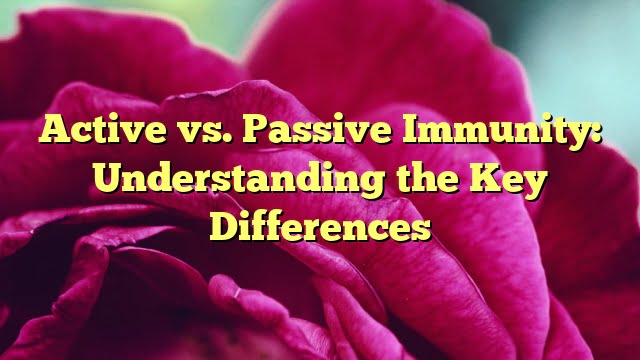Immunity is the body’s remarkable defense system against the onslaught of pathogens and foreign invaders. It’s a complex and intricate web of biological processes that shields us from infections and diseases. Within the realm of immunity, two distinct forms stand out: active immunity and passive immunity. These two facets of our immune response have fundamental differences that are essential to comprehend. In this exploration, we will delve into the world of active and passive immunity, deciphering their unique characteristics and the ways they safeguard our health.
The Building Blocks of Active Immunity
Active immunity is the body’s response to an antigen, resulting in the production of antibodies within the host’s own system. This is a dynamic, self-driven process where the immune system encounters a foreign invader, such as a pathogen, and mounts a defense by generating specific antibodies to combat the threat.
Here are the key attributes of active immunity:
- Antibody Production: Active immunity is primarily characterized by the host’s immune system producing antibodies in response to the presence of antigens.
- Direct Antigen Interaction: It is initiated by direct contact between the immune system and the antigen, activating the immune response.
- Durability: Active immunity is known for its longevity, often providing protection for a lifetime. This is due to the development of immunological memory, which means the immune system “remembers” the antigen and can respond more effectively upon re-exposure.
Passive Immunity: Borrowed Shields of Protection
Passive immunity, on the other hand, is quite different in nature. It doesn’t involve the host’s immune system creating its own antibodies but instead relies on the introduction of pre-formed antibodies from an external source.
Here are the defining characteristics of passive immunity:
- Exogenous Antibodies: Passive immunity is acquired when antibodies are produced outside the body and then introduced into the host.
- Immediate Protection: This form of immunity offers rapid protection because it doesn’t require time for the immune system to generate its own antibodies.
- Lack of Immunological Memory: Unlike active immunity, passive immunity does not contribute to the development of immunological memory. This means that once the borrowed antibodies dissipate, the host is left without long-term protection.
- Limited Duration: Passive immunity provides temporary safeguarding, typically lasting for a few weeks or months. It is not a long-lasting solution.
Instances of Active and Passive Immunity
To comprehend these concepts better, let’s explore some real-world examples:
Active Immunity:
- Natural Immunity: This type of active immunity is acquired through direct exposure to a disease-causing organism. When someone becomes infected with a pathogen, their immune system responds by producing antibodies to fight off the infection. This leads to the development of immunity to that specific disease.
- Vaccine-Induced Immunity: Vaccines are designed to stimulate an immune response without causing the disease itself. They contain either weakened or inactivated forms of the pathogen or specific antigens. When administered, vaccines trigger the immune system to produce antibodies against the target pathogen. Vaccine-induced immunity is a safer and more controlled method to develop active immunity without the risk of the actual disease.
Passive Immunity:
- Maternal Passive Immunity: During pregnancy, mothers transfer antibodies to their babies through the placenta. These antibodies provide infants with temporary protection against various diseases, offering vital early immunity until the child’s immune system matures.
- Immune Globulin: Immune globulin is a blood product containing a high concentration of antibodies. It can be administered to individuals when immediate protection from a specific disease is needed. This could be in response to an outbreak or after potential exposure to a pathogen.
The Balancing Act
The choice between active and passive immunity often depends on the circumstances and the level of protection required. Active immunity, while taking time to develop, offers long-term safeguarding and the advantage of immunological memory. It’s the body’s way of learning from past encounters with pathogens and being better prepared for future challenges.
In contrast, passive immunity provides immediate but temporary protection. It’s like borrowing a shield when facing imminent danger. However, this shield lacks the durability and memory of its active counterpart. The borrowed antibodies gradually wane, leaving the host vulnerable once again.
Conclusion: A Blend of Safeguards
Active and passive immunity, though distinct, play crucial roles in our body’s defense mechanism. They complement each other, offering a multi-layered approach to protecting us from infections and diseases. Active immunity builds a robust, self-sustained defense system, while passive immunity steps in when immediate protection is needed.
Understanding the differences between these two forms of immunity is vital, as it influences medical practices, such as vaccination strategies and treatments for various diseases. Both active and passive immunity have their place in the intricate web of our immune system, working tirelessly to keep us safe from the ever-evolving world of pathogens and foreign invaders.

